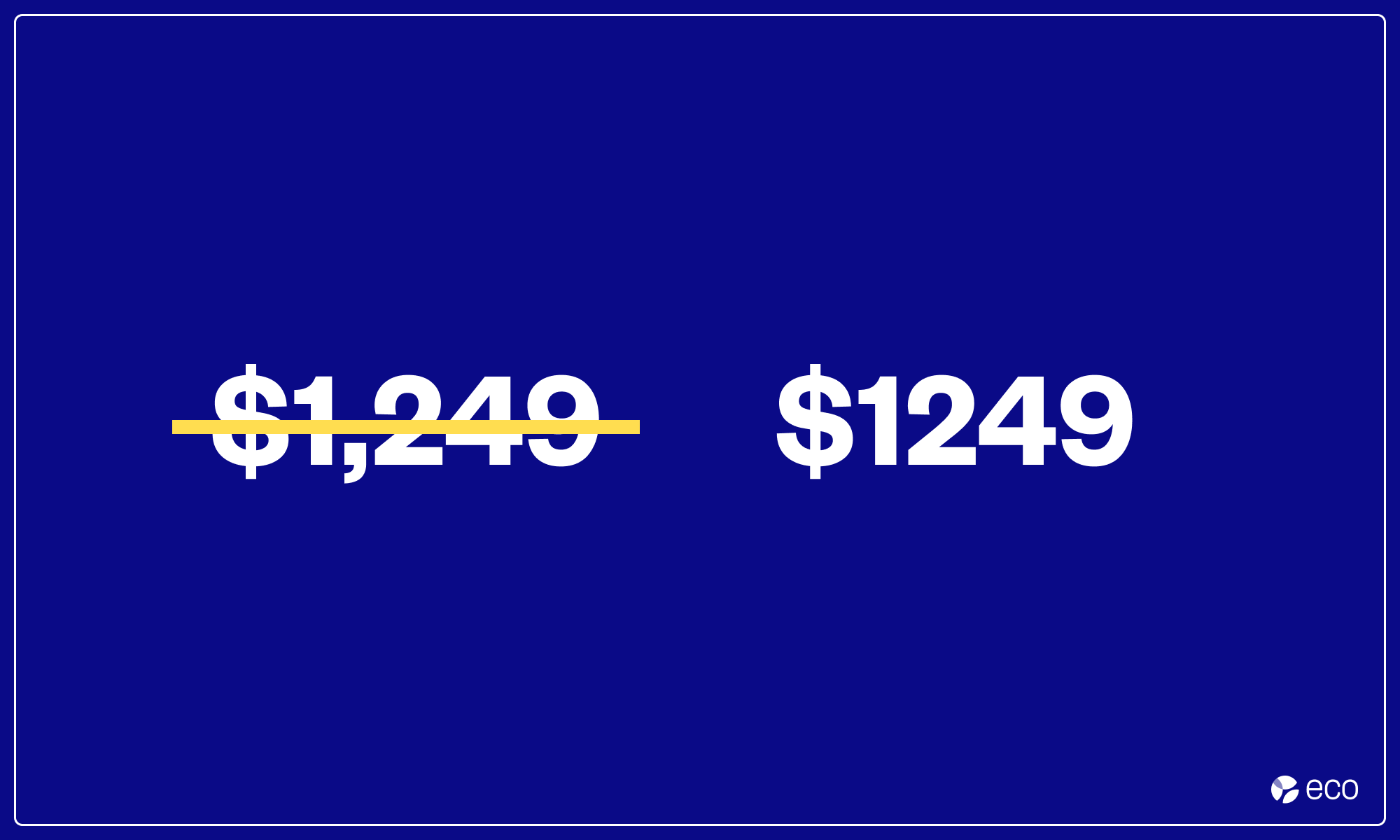10 psychological tricks to make you buy more
These 10 common psychological tricks are used to make you open up your wallet. Knowing how to identify them might help you keep it closed.

Salesmanship is a craft—as well as a playbook. Businesses spend a lot of money and brain power figuring out how to make their product or service stick out from the crowd. Sometimes, they resort to tried-and-true methods that exploit our innate cognitive biases.
Below are 10 common psychological tricks used to make you open up your wallet—or enter your Eco Debit Card numbers (at least you’ll get cash back and earn Eco Points).
As always, knowledge is power, so keep this list handy next time you get pulled in by a decoy product or the lack of a comma.

Bye-bye comma
Visual perception of prices impacts our memory, as a 2012 research article discovered. That means $1,249 seems more expensive than $1249. How is that possible? As the researchers note: longer processing time.
There are more syllables associated with the price-name in the former instance, and therefore that price takes longer to process. Longer processing time, in turn, leads to greater magnitude perceptions.
Next time you see any price in the thousands or more without any commas, you’ll know that the lack of punctuation was intentional.
Decoy alert
You’ve likely seen this a million times: a small soda costs $2.50 while the large, which comes in a cup four times the size, is $3. The smaller beverage is purposefully designed to seem inferior.
This is known as the decoy effect, a term originally coined in 1982 that has since proliferated across many industries. Marketing professor Gary Mortimer breaks down why decoy pricing is so effective:
What asymmetric domination means is the decoy is priced to make one of the other options much more attractive. It is “dominated” in terms of perceived value (quantity, quality, extra features and so on). The decoy is not intended to sell, just to nudge consumers away from the “competitor” and towards the “target” – usually the more expensive or profitable option.
The paradox of choice paralyzes consumers. Too many options can feel overwhelming, and the shopper often walks away. By forcing a seemingly more beneficial (and definitely more expensive) option onto customers, businesses nudge them in the direction that they want.
Maximizing discounts
The higher the number in savings, the bigger the deal the shopper thinks they’re getting. Here’s the rub: it doesn’t matter if that number is a dollar amount or a percentage.
If you’re shopping for a $50 blender and find out that it’s on sale for $10 off, that might make you click “purchase.” Yet you’re more likely to add to cart if the blender is on sale for 20% off. Sure, you’re still only saving $10, but that 20 jumps right off the screen.

Pricing mechanics
One of the most common pricing techniques in existence is the 99-cent rule: price your album at $9.99, not $10, even if that penny is ultimately insignificant. In reality, it’s of extreme importance, given our bias to the lower number.
An even stranger technique is odd-even pricing. Under this rule, $9.99 is completely acceptable, but not $8.99, as that’s an even number followed by two odd numbers. In this case, $8.88 would be the way to go.
Interestingly, odd pricing strategies were invented in order to force cashiers to open register draws to provide change (and not pocket the money). Over time savvy marketers realized numbers have a psychological effect, as well as an effect on their bottom line.
Sense of urgency
As we covered in our post about dark patterns, a false sense of urgency is a common technique: only three left in stock! Turns out this trick works in both real-world storefronts and smartphone browsers.
By making supply appear limited, or “ending” the sale in an hour (even though the time would be added back if you open another browser), marketers want you to feel like you’ll get the deal of a lifetime if you act immediately—ideally, before you really have time to think through your decision.
Time is (sort of) money
Compare the difference between these two marketing pitches:
Our productivity app is 25% cheaper than our competition
Our productivity app gives you 25% more time back with your family
Which one do you think will work with more people? Sure, saving 25% is great, but having more time with the people you love is more valuable than any discount. Hitting emotional cues is way more powerful than landing a quick financial punch.
When you can transcend money by entering the world of emotions, you’ve struck gold—and ironically, you’ll make more money from those who think they’ve just transcended it.

Visual contrasts
Commas matter, percentages matter—and so do colors. And fonts. Lining up an original price and sale price with the same shade and weight is nowhere near as stimulating as a big bold original price with a smaller, but brighter, sales price.
An important rule of thumb in design is to draw the eye to one thing first. Flat 2D letters with no contrast is hypnotizing; mixing up sizes and colors stimulates the mind—and, ultimately, the wallet.
What dollar sign?
Ok, let’s keep adding to the list: no commas and no dollar signs. Upscale restaurants are especially good at this trick.
Grass-Fed Filet Mignon $74
Grass-Fed Filet Mignon 74
Cornell University research found that
Contrary to expectations, guests given the numeral-only menu spent significantly more than those who received a menu with prices showing a dollar sign or those whose menus had prices written out in words.
The dollar sign immediately invokes money, whereas a lack of the sign keeps the meal more nebulous, letting the diner focus on what matters most to them—the meal. Meanwhile, what matters most to the restaurant is also secured.
Words matter—the smaller, the better
Describing an object with words that evoke a sense of smallness and ease makes a purchase more likely. For example, cars sold as “high performance” do not fare as well as cars marketed as “low maintenance.”
Our brains are designed to conserve energy at all costs. A product that makes our life easier will always be more valuable than a product that adds performance. And so crafty marketers focus on convenience whenever possible.

Wow, that’s expensive
When Trader Joe’s launched Two Buck Chuck in 2002 (actually, $1.99, as they know the rules) wine enthusiasts and vino newbies were amazed that any bottle could retail at such a price. Sure, inflation has forced it up a bit, but still rather affordable at $3.79.
Here’s where it gets interesting: that two-dollar bottle would seem even more like a deal if it was paired with a $200 bottle. (Forget that people are terrible at comparing different tiers of wine.) Restaurant owners sometimes slip in a bottle so absurdly priced that any other option seems worthwhile. If you know you’d never buy that $2,000 bottle, well, a $200 bottle isn’t that bad!
One downtown Los Angeles restaurant even listed Two Buck Chuck for $500—although if anyone seriously inquired, they’d let them in on the (sort of) joke.